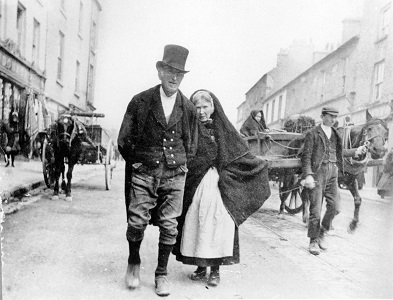FAIR DAY IN WILLIAMSGATE STREET

by Tom Kenny
This very attractive study of Mr. And Mrs. Broderick from Ballintemple was taken in Williamsgate Street c. 1885. They were all dressed up coming into town for the fair or market ... she in her Sunday best and he in his plus fours, tail coat and top hat on. Many people who came in from the country for the occasions like this would have been similarly dressed.
Williamsgate Street was the main entrance to the city in medieval times. It has not changed very much in the last 100 years, except for the impact the big fire of 1971 made on some shop fronts.
The building near the Eyre Square end of the street on the right was Bartley Roche’s pub. It had been a bakery in the early 1800’s and in 1912 Mr. Roche sold it to the Logue family who converted it into a shoe shop. Ball Alley Lane was between it and the Cash Company and on this side of that building was McCullagh’s. They were booksellers, print sellers, picture framers, they sold quality stationery and later on, phonographic records.
Next door would become McDonnells in 1904; a tea room where ladies and gentlemen could have freshly made tea and cakes; ice cream in 24 hours, jellies, blanc manges, meringues and pies could be made to order. This premises was a favourite of the Volunteers around the time of the Rising and the War of Independence. There was a hall at the back which they used regularly for drilling purposes.
Corbetts opened their shop beside McDonnells in 1894. It was a kind of one-stop shop where you could buy fowling pieces, portmanteaus, perambulators, mail cars, threshing machines, wall paper, non-poisonous sheep dip etc. The building and the business were destroyed by the fire of 1971 and was eventually rebuilt as Corbett Court.
Next to that was O’Donnells, the House for Irish Souvenirs where they sold Beleek, china, coats of arms, Conamara Marble and Galway-made toys. Nolan’s butcher shop was next door. It was sold in 1892 to John Kirwan, one of whose daughters married John Whelan from Shanaglish. He opened a chemist shop there in 1898. Beside that was Giles’ Grocery and Sweet Shop, then there was an entry into an alleyway which led to the Castle Barracks, and finally there was Dillons’ Jewellers which opened in 1750.
The first building on the left, out of picture, was McNamara’s high class grocery, and next to it Stephen Faller’s who moved his jewellery shop here from Dominick Street in 1879. Beside them was Costelloe’s butcher shop. Frank McDonagh’s was next door, the leading department for ladies and gents wear, which opened in 1883. You can see the shawls hanging outside his door. Then there was Donovan’s Sweet Shop which seemed to have everything for the sweet tooth. The last premises was Leahy’s which had the largest and finest stock of leading makers of tobaccos, cigarettes, pipes and cigars including cigar holders mounted in gold and silver.
On Saturday next, June 3rd, Dr. Ian Walsh from NUIG will give an illustrated talk on “John Millington Synge and the Aran Islands” in Galway City Museum. All are welcome, but booking is advisable.
